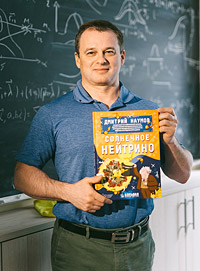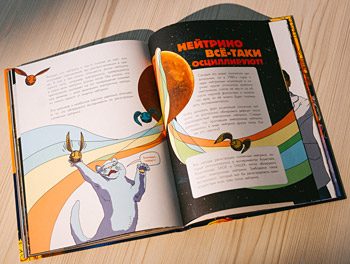
Electronic english version since 2022 |
The newspaper was founded in November 1957
| |
Scientists to schoolchildren
About solar neutrinos and children's literature
At the International Literature Fair "Non/fictioN Spring - 2024" there was a presentation of the book "Solar Neutrino" by Deputy Director of the Laboratory of Nuclear Problems for Research, Head of the JINR Neutrino Programme, Doctor of Physics and Mathematics Dmitry NAUMOV. The book is dedicated to the fascinating history of the origin of the Sun and planets and also examines one of the most mysterious particles in the Universe - the neutrino.
 Solar neutrinos are extremely light and weakly interacting particles that are produced as a result of thermonuclear reactions in the core of the Sun. These reactions, in which hydrogen is converted to helium, are the source of solar energy. Neutrinos hardly interact with matter that allows them to freely leave the solar core and to reach Earth in a matter of minutes.
Solar neutrinos are extremely light and weakly interacting particles that are produced as a result of thermonuclear reactions in the core of the Sun. These reactions, in which hydrogen is converted to helium, are the source of solar energy. Neutrinos hardly interact with matter that allows them to freely leave the solar core and to reach Earth in a matter of minutes.
The book was included in the fair's top list in the category "Ten best educational children's books by Russian authors". We talked to the author Dmitry Naumov about whether it is easy for a scientist to write for children.
Dmitry Vadimovich, what is your book about? What issues does it pose? How much of your research work is reflected in the book?
- The focus is on testing the hypothesis about the mechanism of solar energy generation, in which solar neutrinos play a key role. Research into solar neutrinos has revealed an unexpected discrepancy between the expected and actual numbers of these particles, resulting in the so-called "solar neutrino mystery". This issue has worried the scientific community for four decades and was successfully resolved thanks to international efforts, including the participation of Dubna scientists. Such as, Oleg Smirnov from the Laboratory of Nuclear Problems, as part of the Borexino collaboration, made a significant contribution to solving this riddle and this year, he presents his paper for the defense of the degree of Doctor of Physical and Mathematical Sciences.
Although I have had little personal involvement in solving this mystery, I have been very interested in studying and writing about the contributions of the remarkable scientists that have worked on this issue. My own scientific work is closely related to the topics covered in the book that allowed me to dive deeply into the context and to provide a comprehensive and understandable explanation of the intricacies of work in the fields of astrophysics and particle physics to the young reader.
What will the investigation of solar neutrinos give humanity?
- This is of great importance for humanity and there are many reasons for it.
For example, with the help of neutrinos it has been confirmed that the Sun's main source of energy consists of thermonuclear reactions. This is a key element in understanding how stars shine and how energy is generated in the Universe.
Also, observations of solar neutrinos allowed scientists to find out that neutrinos have mass, although very small. This discovery was sensational because previously it was believed that the mass of neutrinos was zero.
 Research has shown that neutrinos are capable of changing from one type to another on their way to Earth. This phenomenon, known as neutrino oscillation, indicates that different types of neutrinos have different masses and can interact with matter in different ways.
Research has shown that neutrinos are capable of changing from one type to another on their way to Earth. This phenomenon, known as neutrino oscillation, indicates that different types of neutrinos have different masses and can interact with matter in different ways.
Neutrino oscillations provide a unique opportunity to explore new aspects of fundamental interactions that are not described by the current theoretical model of particle physics.
Although on the horizon, understanding neutrinos could result in the development of new technologies based on the unique properties of these particles, such as in the areas of detection and communication.
Thus, the investigation of solar neutrinos not only expands our knowledge of the Universe, but also opens promising areas for further research and potential technological breakthroughs.
Tell us, please, about how scientists catch solar neutrinos.
- Registering solar neutrinos is a difficult task due to their extremely weak interaction with matter. Despite the fact that billions of neutrinos pass through every square centimeter of the Earth every second, they are extremely difficult to detect. Specialized neutrino detectors are used for it that are often positioned in areas protected from other types of radiation, such as underground laboratories or even inside mountains, to minimize background interference from cosmic rays and other radiation sources. Here are several techniques used to detect solar neutrinos:
Scintillation detectors. In these facilities, neutrinos interact with matter, causing instantaneous flashes of light - scintillation. These flashes are then registered by sensitive detectors. An example of such a detector is the Borexino experiment in Italy.
Detectors based on Cherenkov radiation. When particles such as neutrinos move through a transparent environment, such as water, faster than the speed of light in that environment, they emit Cherenkov radiation. This radiation can be registered using photomultiplier tubes. One of the most famous such detectors is the Super-Kamiokande in Japan.
Radiochemical detectors. These detectors use the transformation of some nuclei into others under the impact of neutrinos. For example, in the Homestake detector experiment, neutrinos interacted with chlorine atoms, turning them into argon atoms that were then measured.
In each of these techniques, the key is to reduce the background radiation and to increase the sensitivity of the detectors in order to most efficiently detect rare events in the interaction of neutrinos with matter. These technologies allow scientists to accumulate relevant data about solar neutrinos and use them to study both solar processes and the fundamental properties of this particle.
How did you come up with the idea to write a book for children? This is your first experience writing a book for a children's audience. Do you consider it successful?
- The idea to write a book for children came unexpectedly: in the summer of 2021, the editors of "Avant" of the publisher AST invited me to write a book within the framework of the "Big science for children" series. Although I had no prior experience in writing books for children's audiences, regularly lecturing to a wide range of audiences, including schoolchildren, gave me the confidence to take on this challenge.
I chose the topic of the book based on the need for an exciting plot with elements of drama and a positive ending. The history of solar neutrinos, spanning four decades of intense research, seemed ideal for this format. This story is not only fascinating, but also educational, opening doors to the wonderful world of scientific discoveries for young readers.
Regarding the success of the project, it seems to me that the best estimation can be given by the readers themselves. According to the first responses, the book arouses interest and positive emotions among the audience that makes me think about my further work in this area. Knowing that my work helps younger generations to discover science makes this experience meaningful and hopefully successful for me.
Is it easy to write for children? What is special about this audience? How should you teach children about science?
- Writing for children is a big challenge. This task is much more difficult than holding a scientific seminar for colleagues, since a children's audience requires a special approach. It is necessary to use accessible language, appropriate images and metaphors and carefully select the matter to be presented, while maintaining honesty in the presentation of information. Despite their apparent simplicity, lectures for children require more in-depth preparation and thought.
When I started writing my book, I thought about how exactly I would do it. Remembering the books that I liked as a child and those that caused rejection, I realized that I did not like being treated like an incomprehensible child. At the same time, I could play chess in my head with several opponents at the same time, without looking at the board and calculating dozens of moves in advance. Many adults could not cope with such a task. This experience taught me to respect the interlocutor, regardless of his age. In my book, I strive to speak to readers as equals, using simple and understandable language.
The book contains illustrations that help you to better perceive and understand scientific ideas. The concepts for all the drawings were developed by me in collaboration with editor Dmitry Kalinin and art editor Ekaterina Gordeeva. They were brilliantly brought to life by the talented artist Alexander Nenashev. Many of the illustrations are made in a humorous and paradoxical style that allows one to approach the presentation of ideas from different angles, increasing the chances that readers will find something for themselves.
How many people were involved in preparing the book? How long did it take to prepare the book?
- In the summer of 2021, I started writing a book, but due to the heavy workload at my main job, I completed the text only by December of the same year. In the writing process, my reviewers helped me: my father Vadim Aleksandrovich Naumov, an outstanding theoretical physicist (BLTP - editor's note), my wife Elena Aleksandrovna Naumova (DLNP - editor's note), as well as friends: an outstanding scientist and popularizer of science Igor Pierovich Ivanov and solar neutrino expert Oleg Yurievich Smirnov (DLNP - editor's note). My graduate student Vladimir Allakhverdyan checked the writing on analogies and all the numbers mentioned in the book. Literary editor Natasha Mazarskaya carefully edited the entire text. I am eternally grateful to all of them for their contributions, thanks to which the quality of the matter presented in the book has increased significantly.
We spent the next two years working on illustrations for the book. Editor Dmitry Kalinin, art editor Ekaterina Gordeeva and artist Alexander Nenashev played a huge role in this process. Thanks to their talented and dedicated work, the book turned out exactly as you see it now. I am also grateful to other employees of the Avanta editorial staff and the AST publisher for their valuable contribution to the publication of the book.
Do you have any plans to write other children's books?
- Yes, I do have plans to write other children's books. In the process of working on the current book, so much text accumulated that it had to be divided into three parts. Today, I have two books ready for revision. In addition, during the writing process, many new ideas for future writings arose. I hope to find time for new books so that it does not interfere with my main work.
Tell us, please, about the projects you currently work on.
- Currently, I work on a number of projects as part of my position as Deputy Director of DLNP JINR. My main responsibilities include being head of the Institute's Neutrino Programme. As a scientist, I am extensively involved in the Baikal-GVD projects, where I am leader of the group developing the experimental simulation programme and JUNO that goes into operation this year. In addition, I teach and work with graduate and undergraduate students and train scientific personnel. I have also prepared an extensive textbook on quantum theory for experimentalists that runs to over 500 pages. I currently edit it and I am going to publish it this year. In addition to it, I write scientific articles and there are plans to write scientific books and textbooks.
The article was prepared by Ksenia MORUNOVA,
photo by Daria KONOVA